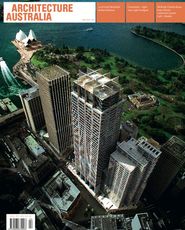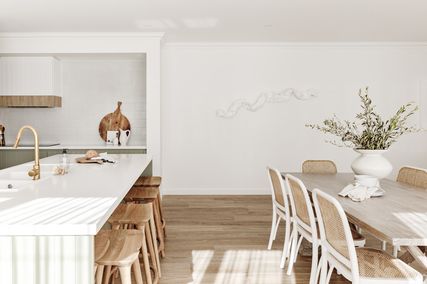Photography Brett Boardman
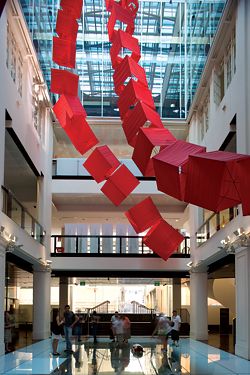
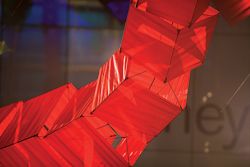
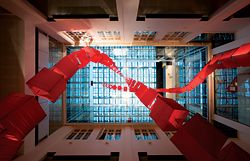
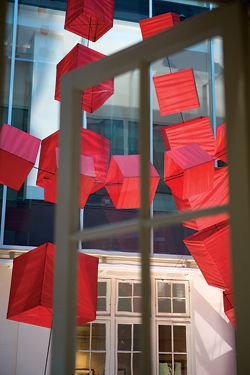
Anuradha Chatterjee reviews an installation by Patrick Keane at Sydney’s Customs House.
Stitching the Void, an exhibition of installation and digital animation by Australian-born Patrick Keane, showed at Customs House, Sydney, early this year. A combination of physical and digital forms of representation, the installation consisted of eighty-four red cubes of varying sizes. The largest cube was two metres wide and the smallest one ten centimetres wide. The installation was complemented by digital animations on the media wall (subsequently replaced by videos relating to the two concurrent exhibitions, China Diaries: A Photography & Video Exhibition and China Dreaming).
Suspended over five floors to fill the Customs House atrium, Stitching the Void was one of the largest indoor installations in Australia. It was made through a creative collaboration between Keane and Michael Richards of KiteMagic. The lightweight cubes were produced by stretching kite material over a rigid frame of carbon fibre rods. The composition appears suspended from the ceiling of the atrium, but it is also stretched and pulled into position by thin iron cables that hold the entire composition in place. Assembling it required sixteen hours, three riggers and four abseilors.
The installation is based in digital technology. Keane explains that the work is a representation of the post-digital age. It is part physical and part digital. On one hand, it is physical yet ephemeral, light and transient. On the other, the concept is based on a digital script of the Game of Life. Invented in 1970 by British mathematician John Horton Conway, the Game of Life is not really a game. The player sets up a starting configuration and then watches it evolve from that original state. It needs no further input from the player. Fundamentally, the game consists of a two-dimensional orthogonal grid of square cells. These cells live or die by interacting with neighbouring cells. Keane scripted the game with the help of Maya software, converting the two-dimensional cellular game into a three-dimensional animation consisting of materializing and dematerializing cubes. A specific moment in this relentless game was then frozen and transformed into physical reality.
The installation also makes a contribution to architectural design theory. Firstly, the title refers to the analogy between textiles and architecture. While the installation itself is made of kite fabric, the analogy is more complex. The use of iron nets and meshes as connective tissue between buildings underpins the practice of architect Dominique Perrault, specifically his proposal for CCTV Building, Beijing, China, 2002, and Las Teresitas, Tenerife, Spain, 2003. However, Keane moves beyond this. He believes that the void (or the atrium) is the emptiest part of any building. Through the Game of Life, a three-dimensional weave is generated, in which a dense composition of repeatable units appear and disappear, like alternating threads in a woven fabric. A very specific part of this dynamic composition is then used to connect the different parts of the atrium. Secondly, the installation makes a significant contribution to an emerging field of practice and scholarship – that of self-generative architecture. The process of scripting undermines the control the designer has over the process of design. In this way, it challenges authorship and intention, and emphasizes automation and evolution as a design method.
Experientially, Stitching the Void is a contextual response. It fits into the atrium of Customs House. Ordinarily, a view up the atrium would reveal the reflective surfaces on the upper levels, the flat orthogonal patterns in the skylight and the panelled window frames on level two. These patterns bounce off one another to form a complex image composed of overlapping squares and rectangles. The installation resonates with these characteristics of the atrium, because of its lightness as well as its upward progression and diminution. Had the installation been installed in a blank corporate space, it would have had a dramatically different effect. Also, wittingly or unwittingly, the installation fits in with the China Diaries and China Dreaming exhibitions that mark the Chinese New Year celebrations in Sydney. The fragile but rigid form of the cubes, the colour, the lighting and their suspension evoke images of Chinese lanterns. Furthermore, due to the upward surge and the sinuous forms, the installation bears a faint resemblance to the icon of the dragon in Chinese mythology. It is fair to say that the installation reconciles high art and multicultural Sydney. Stitching the Void is not only a visually enriching experience, it is also technically, conceptually and culturally sound.
Dr Anuradha Chatterjee is an architect and scholar, currently working as senior research associate at UTS and as sessional faculty at UNSW.
STITCHING THE VOID, CUSTOMS HOUSE, SYDNEY
Designer
Enter Projects project team—Patrick Keane, Esan Rahmani, David Allan, Morris Olivero, Harry Sonella, Austin Atherton, Alison Aldrich.
Fabricator
Michael Richards, KiteMagic.

